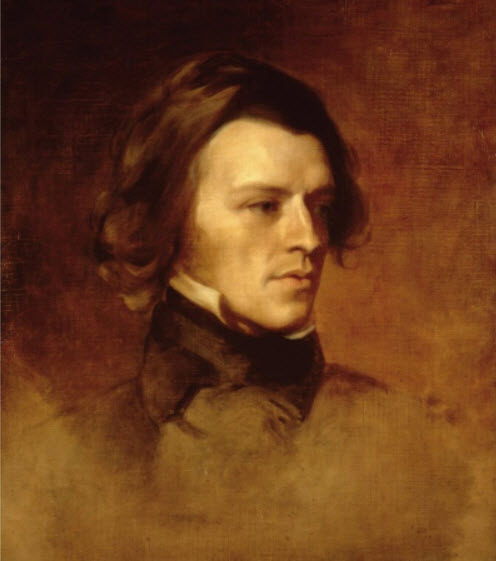Summary | Excerpt | Reviews | Beyond the Book | Read-Alikes | Genres & Themes | Author Bio

A Novel
by Alice WinnThis article relates to In Memoriam
 In Alice Winn's brilliant World War I novel, In Memoriam, the main characters often quote poetry by Alfred, Lord Tennyson (1809-1892). Among others cited is one of his best-known works: In Memoriam A.H.H.
In Alice Winn's brilliant World War I novel, In Memoriam, the main characters often quote poetry by Alfred, Lord Tennyson (1809-1892). Among others cited is one of his best-known works: In Memoriam A.H.H.
The subject of the poem is Arthur Henry Hallam, whom Tennyson met at Trinity College, Cambridge, in 1829. The two young men were members of The Apostles, a secret society that met to debate philosophical, political and literary topics, and it was there that they formed a close friendship. Hallam was frequently invited to stay with the Tennyson family at their house in Somersby, Lincolnshire, and during Easter vacation in 1930 Hallam proposed marriage to Tennyson's sister, Emilia (familiarly known as Emily), which she accepted.
Already a well-known poet and literary critic, Hallam was instrumental in launching Tennyson's career. He sent one of Tennyson's works (without permission) to Edward Moxon, publisher of The Englishman's Magazine. It was subsequently printed in 1831, with an essay by Hallam published in the same issue which reviewed the poem favorably. There is no record of Tennyson's reaction to this, but his friendship with Hallam remained strong and the pair went so far as to propose collaborating on a book of poetry in 1833.
Before their plans could come to fruition, Hallam tragically died of a cerebral hemorrhage while on vacation with his father in Vienna; he was just 22 years old. The unexpected death of his companion threw Tennyson into a deep depression that lasted years. According to the British Library, however, "Scholars agree that this was the most important event in Tennyson's life and the one that most shaped his work."
In Memoriam A.H.H. was composed in response to Hallam's demise. The poem was written over a 17-year period and originally published anonymously in 1850, though by the end of that year Tennyson's identity had been revealed. It is comprised of 131 separate lyrics (in poetry, a poem or section of a poem expressing personal feelings) of varying length plus a prologue and epilogue. As one might expect, it's an elegy for his lost companion, and explores Tennyson's deeply personal feelings and intense sorrow over Hallam's untimely death. The British Library summarizes the journey the poet takes in overcoming his grief: "The initial response to bereavement is a stunned sense of loss and grief, with lamentation for the dead person. This is followed by recollection of their fine qualities. Gradually a sense of acquiescence emerges, leading eventually to a more serene state and to solace for the loss."
The intense devotion and tenderness Tennyson expresses for Hallam has led to speculation that the two were lovers. According to a British Library article, "Contemporary reviewers responded anxiously to the poem's homoeroticism; an early review in The Times complained about the tone of 'amatory tenderness.'" The debate continues today; many scholars feel that to view the poem as an expression of romantic love is to read it in a modern context, and point to the lack of evidence that either had intimate relationships with other men (Tennyson married and had two sons after Hallam's death). Others argue that it is important to acknowledge how the poem subverts Victorian norms of heterosexuality and masculinity with verses that express the poet's longing for his friend's touch, as well as lines that compare the author's feelings to those of a young girl awaiting her lover.
The poem was well-received upon its publication and became one of Tennyson's best-known works. Queen Victoria took solace in it after the death of her husband, Prince Albert, in 1861, writing in her diary that she was "much soothed" by it. It was also highly influential; Tennyson's strict adherence to an A-B-B-A format has led many to refer to this poetic structure as "IM style." A number of phrases from the poem are still well-known today, perhaps none more so than the last two lines from this verse:
I hold it true, whate'er befall;
I feel it, when I sorrow most;
'Tis better to have loved and lost
Than never to have loved at all.
Alfred, Lord Tennyson, detail of an oil painting by Samuel Laurence, c. 1840; in the National Portrait Gallery, London.
Filed under Books and Authors
![]() This "beyond the book article" relates to In Memoriam. It originally ran in May 2023 and has been updated for the
March 2024 paperback edition.
Go to magazine.
This "beyond the book article" relates to In Memoriam. It originally ran in May 2023 and has been updated for the
March 2024 paperback edition.
Go to magazine.
Your guide toexceptional books
BookBrowse seeks out and recommends the best in contemporary fiction and nonfiction—books that not only engage and entertain but also deepen our understanding of ourselves and the world around us.